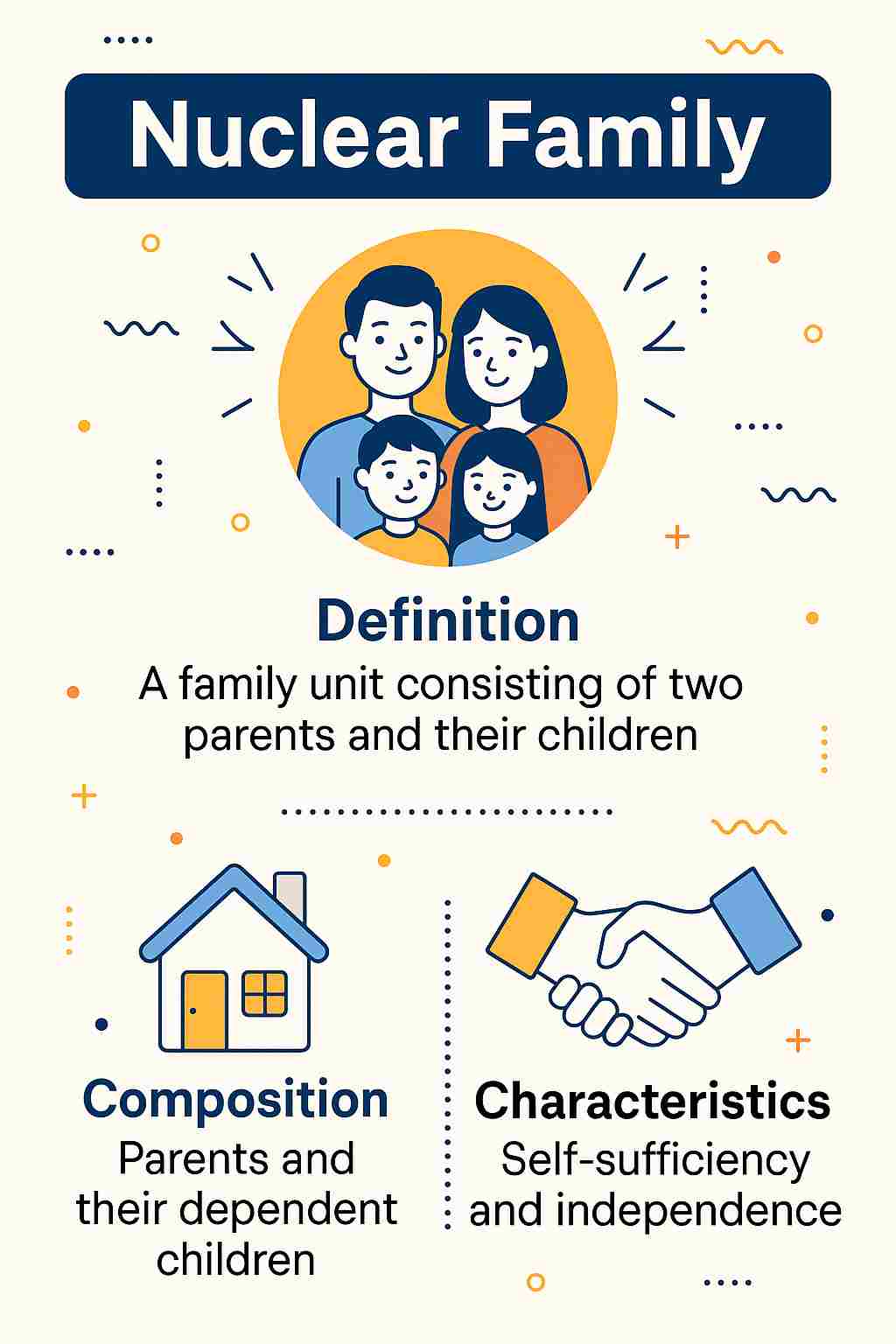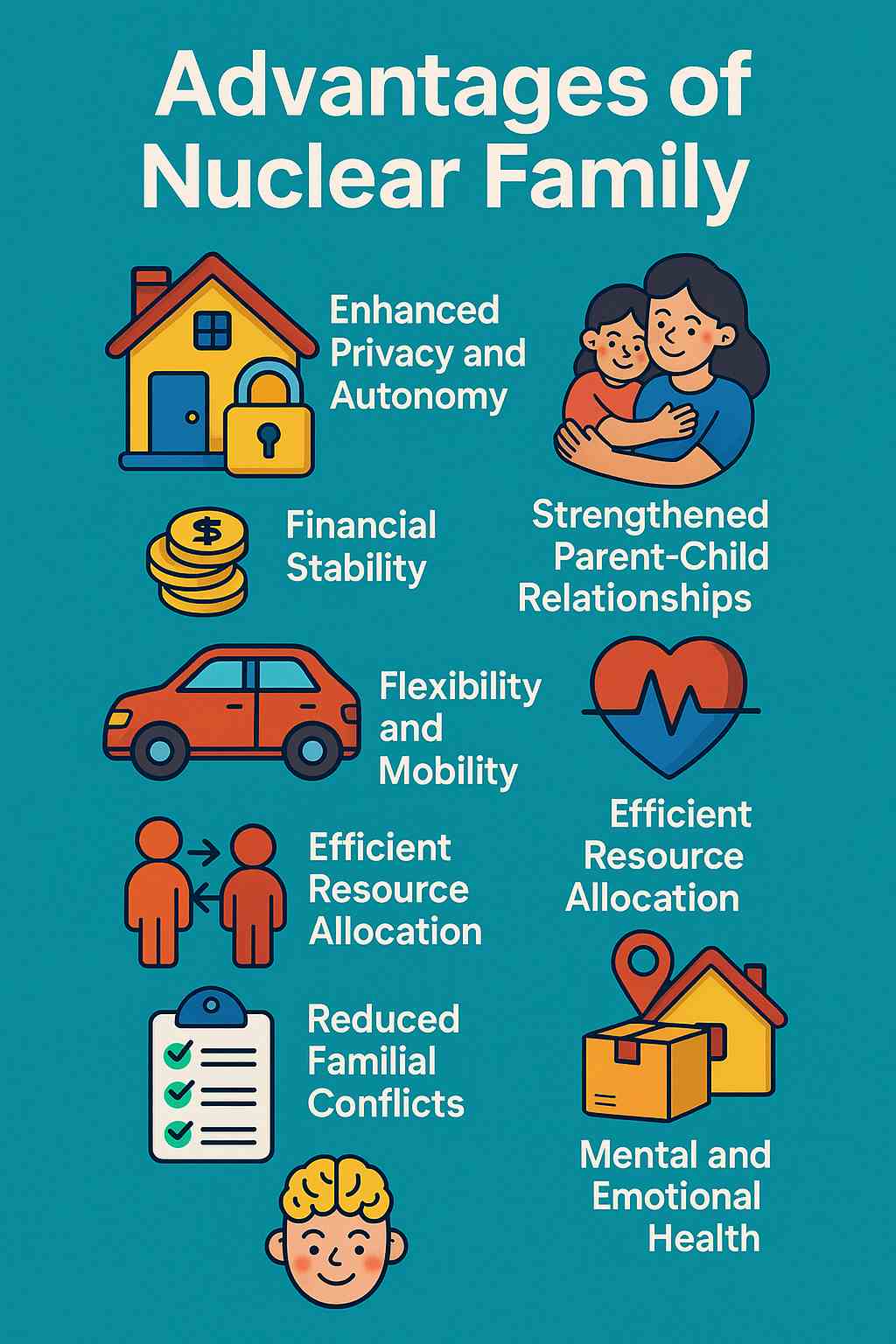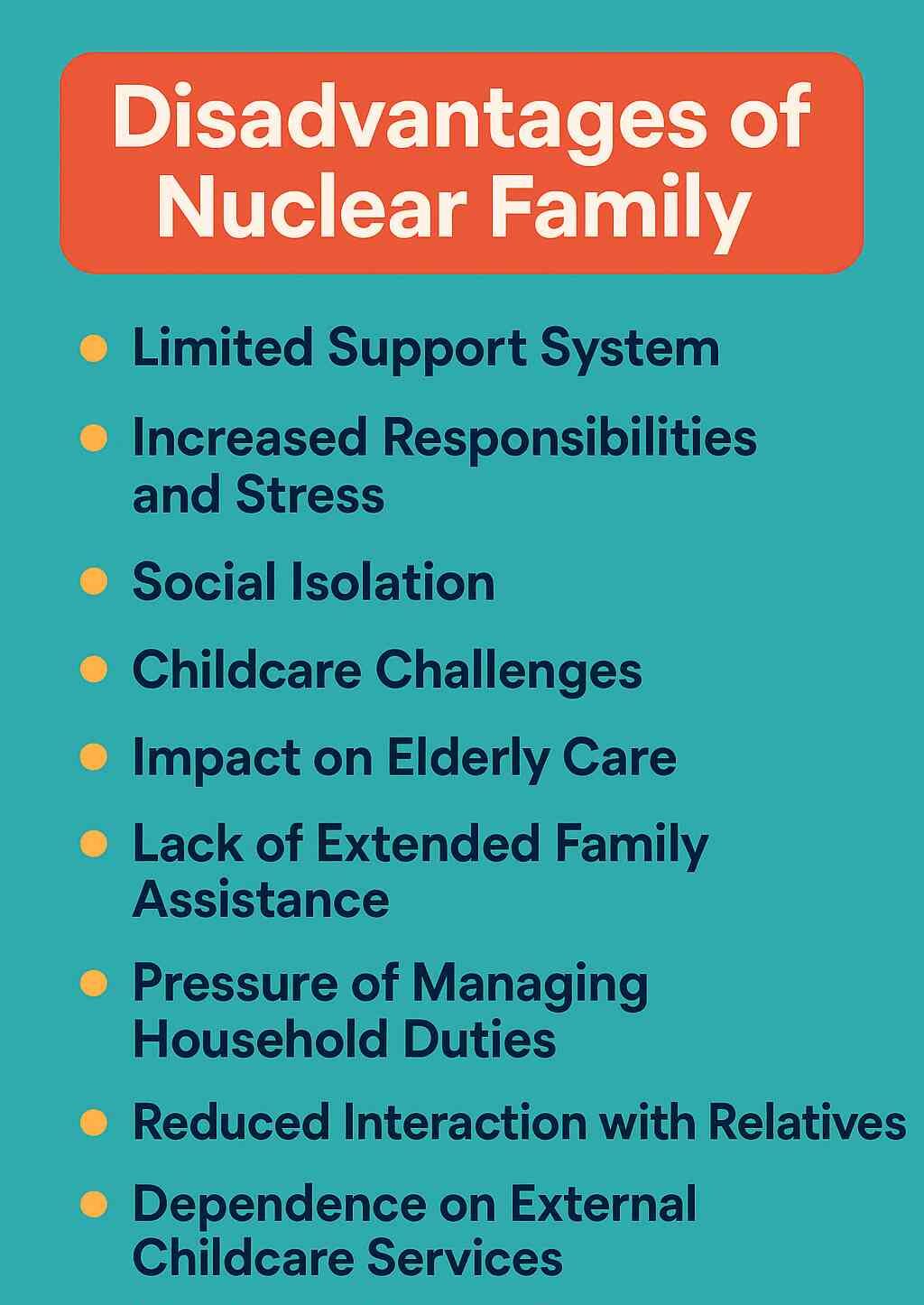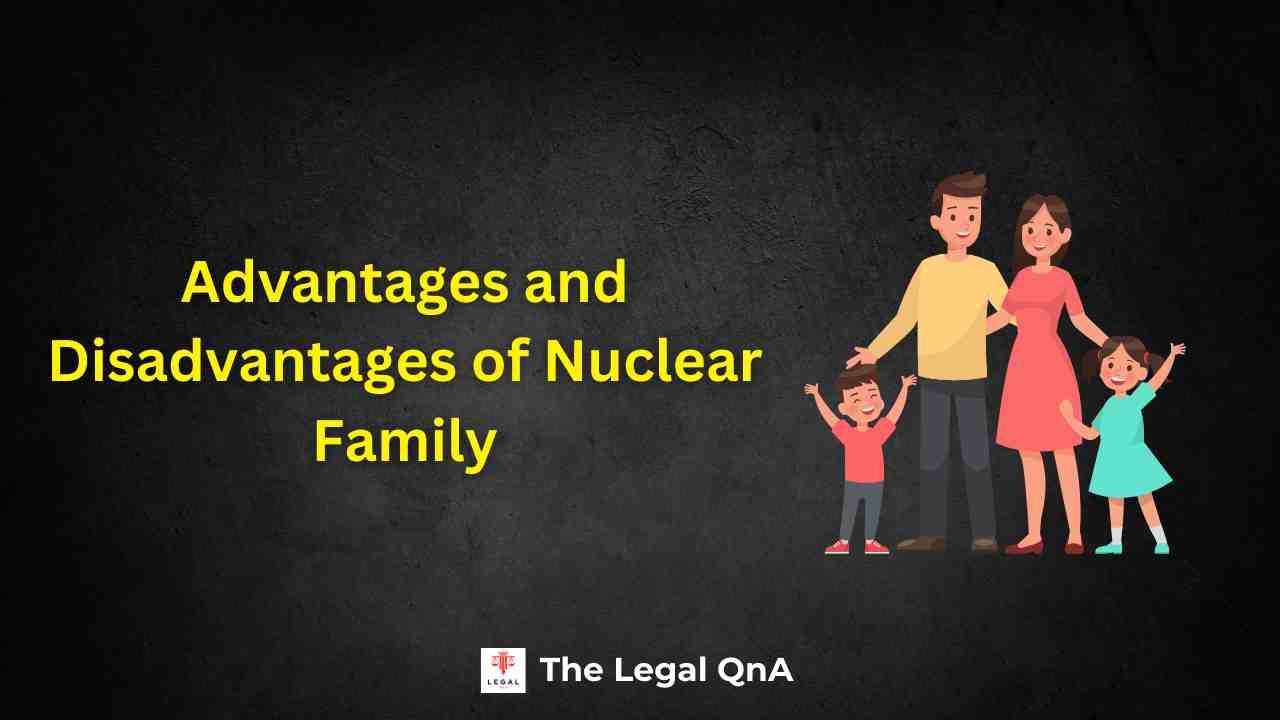The advantages and disadvantages of nuclear family include greater privacy, better financial control, and strong parent-child relationships. However, it can lead to social isolation, lack of extended family support, and increased stress due to limited help with childcare, elderly care, and daily responsibilities.
The nuclear family is one of the most recognizable social units in modern society. Comprising two parents and their children, it has shaped the lives of countless individuals across cultures and generations. Unlike extended families, where multiple relatives live under one roof, the nuclear family focuses on close-knit bonds, privacy, and shared responsibilities among immediate members.
With urbanization, globalization, and changing social norms, this family model has gained prominence in both Western and developing nations. Understanding the definition, legal interpretations, and historical development of the nuclear family helps us appreciate its evolving role in today’s interconnected world.
What is a Nuclear Family?

A nuclear family consists of a married couple and their children, living together as a single household. It excludes extended relatives like grandparents, uncles, aunts, and cousins from everyday residence. The focus is on direct parental responsibility, individual autonomy, and emotional support within a compact unit.
Definitions by Various Jurists and Thinkers
- Murdock (1949): Defined the nuclear family as “a social group characterized by common residence, economic cooperation, and reproduction. It includes adults of both sexes, at least two of whom maintain a socially approved sexual relationship, and one or more children.”
- Kingsley Davis: Considered the nuclear family a universal institution, calling it “the basic unit of society that fulfills the functions of reproduction, child-rearing, and emotional support.”
- Robin Fox: Described the nuclear family as “the smallest, organized, durable unit of society that performs essential tasks and ensures survival through cooperation and reproduction.”
- C.N. Shankar Rao (Indian Sociologist): Notes that the nuclear family is “a voluntary union of individuals based on intimacy and emotional satisfaction, primarily involving conjugal ties.”
Historical Evolution of the Nuclear Family
The nuclear family did not always dominate social life. In ancient and medieval societies, joint family systems were prevalent, particularly in agricultural economies where extended kinship supported survival and productivity. The idea of families functioning independently gained traction during the Industrial Revolution.
With the rise of cities, people migrated for work, and smaller households became more practical. In Europe and North America, post-World War II economic booms and suburban development gave rise to a cultural shift favoring nuclear families. Modern conveniences, job mobility, and changing gender roles accelerated this transformation. Today, nuclear families are dominant in urban centers around the world.
Composition of a Nuclear Family
The composition of a nuclear family is straightforward. It usually includes two generations living together, the parents and their children. Unlike joint or extended families, it does not involve grandparents, uncles, aunts, or cousins under the same roof.
In its most common form, a nuclear family consists of:
- One mother
- One father
- One or more children (biological or adopted)
This structure may vary slightly based on personal circumstances. Some nuclear families may be headed by single parents, while others may include step-parents or blended family dynamics. Despite these variations, the defining factor remains that the core unit functions independently, with limited or no involvement from the extended family on a day-to-day basis.
The focus is generally on the immediate members, and all roles and responsibilities, from income generation to caregiving, are managed within this small circle.
Characteristics of a Nuclear Family
A nuclear family has several distinguishing characteristics that set it apart from other family systems:
- Self-Sufficiency: The family unit manages its own affairs without depending heavily on relatives or outside support. This includes financial decisions, parenting styles, and daily routines.
- Greater Privacy: With fewer members in the household, privacy is easier to maintain. Each person often has more personal space and freedom, leading to fewer conflicts over lifestyle or choices.
- Independent Decision-Making: Couples make decisions regarding work, finances, child-rearing, and household matters on their own. This autonomy allows for quicker adjustments and flexibility in managing life’s demands.
- Emotional Bonding: Due to the smaller size of the family, there is often closer emotional bonding between parents and children. This tight-knit structure can create a supportive and nurturing environment for individual growth.
- Role Clarity: Responsibilities within the family are more clearly defined. Parents often divide duties between work and home, while children are guided by consistent rules and expectations.
- Mobility and Adaptability: Nuclear families can easily relocate for work or education without the logistical complexities of moving a larger extended family. This adaptability is particularly useful in modern urban lifestyles.
Comparison with Extended and Joint Families
To better understand the nuclear family structure, it’s helpful to compare it with extended and joint families. While a nuclear family revolves around just the parents and their children, an extended family includes additional relatives such as grandparents, uncles, aunts, and cousins, often living under the same roof or nearby. A joint family is a subset of the extended model but with a closer level of integration. In a joint family, multiple generations cohabitate, sharing income, property, and daily responsibilities.
The main difference lies in the size and shared responsibilities. In joint families, work and caregiving duties are distributed among more people, which can reduce stress for individuals. At the same time, there is often less privacy, and decision-making may require consensus from multiple elders or family heads.
Nuclear families, by contrast, offer more independence. Parents can raise their children based on their personal values and lifestyle without the influence of multiple elders. However, this freedom can come at the cost of limited support in times of illness, childcare emergencies, or elderly care.
Each structure has its own benefits and drawbacks. The right choice often depends on lifestyle preferences, income levels, and cultural expectations.
Cultural and Regional Variations
Family structures, including nuclear families, do not exist in isolation from the cultures and regions in which they develop. For example, in many Western countries like the United States, Canada, or parts of Europe, the nuclear family has long been seen as the standard. Individualism and personal freedom are highly valued in these societies, which makes smaller family units more common and culturally acceptable.
In contrast, many Asian and African societies have traditionally favored extended or joint families. Cultural values in these regions place a strong emphasis on collective living, shared responsibility, and respect for elders. However, this is changing. As urbanization, education, and migration reshape lifestyles, nuclear families are increasingly becoming the norm even in these parts of the world.
India provides a good example of this shift. In urban centers like Mumbai, Delhi, or Bangalore, many young couples choose to live separately from their parents after marriage. Rising costs, job transfers, and the desire for personal space make nuclear families more practical. Yet in rural or traditional communities, joint family setups still hold strong because they offer support in farming, childcare, and maintaining household duties.
Religious and ethnic traditions also play a role. In some Muslim, Hindu, or Christian communities, multigenerational living is still encouraged as a sign of familial unity and moral responsibility. But again, economic conditions and modernization are leading even these groups to reconsider how they define and structure a family.
Advantages of a Nuclear Family

A nuclear family typically consists of two parents and their children, living independently from extended relatives. While this arrangement may seem simple, it offers several practical benefits.
1. More Privacy for Everyone
Living separately from extended family members means each person enjoys greater personal space. Parents and children alike can manage their lives without feeling watched or judged by other relatives. Privacy strengthens individuality and can reduce unnecessary conflict.
2. Freedom to Make Independent Decisions
Parents in a nuclear family can raise their children based on their own values and parenting styles. They don’t have to accommodate the expectations of in-laws or elder relatives when it comes to decisions like education, discipline, or lifestyle. This makes daily life more flexible and personal.
3. Stronger Bond Between Parents and Children
When a family is smaller, the emotional connection between members tends to grow deeper. Parents have more time and attention to devote to their children. In return, children often feel more secure and supported. This closer bond fosters healthy emotional development.
4. Better Financial Control
Managing finances is usually simpler in a nuclear setup. Since the household is smaller, expenses are lower and easier to track. Parents can focus on budgeting for their children’s education, savings, and long-term goals without having to cover the needs of a larger group.
5. Improved Educational Support
With fewer people in the house, there are fewer distractions. Parents can devote more time to helping their children with studies or extracurricular activities. They can also invest more in quality education, private tutoring, or skill development because of focused financial planning.
6. Quicker Conflict Resolution
Family arguments, while normal, can escalate in large households. In a nuclear family, conflicts tend to be resolved faster. Fewer opinions make it easier to find common ground. This reduces stress and maintains harmony at home.
7. Higher Flexibility in Daily Routine
Smaller families can easily adjust their schedules without needing approval from others. Meal times, travel plans, sleeping habits, or weekend outings can all be arranged based on the parents’ and children’s preferences. This flexibility helps reduce friction and boosts satisfaction in daily life.
8. Better Career Opportunities
Nuclear families often relocate to follow job opportunities without much hassle. Since they don’t have to consider the needs of aging parents or dependent relatives, it’s easier for both partners to grow their careers or even move abroad if necessary. This freedom can lead to a better quality of life.
9. Focus on Health and Well-being
Because there are fewer people to care for, parents can concentrate more on their children’s health and emotional needs. It also becomes easier to follow healthy routines like meal planning, regular doctor visits, and physical exercise, which often get overlooked in large, busy households.
10. Consistency in Parenting
In a nuclear family, children are raised by a single set of values and rules. This consistency can provide stability and reduce confusion. When too many elders try to guide the upbringing, children often get mixed messages. A clear and unified parenting approach helps children develop discipline and confidence.
11. Encouragement of Responsibility
Children in nuclear families often learn independence earlier. Since they don’t have multiple relatives doing things for them, they are encouraged to take on responsibilities like cleaning their room, helping with chores, or making small decisions. This early involvement in household life builds maturity.
12. Peaceful Home Environment
Fewer people in the house often means fewer arguments, power struggles, or clashing opinions. A peaceful atmosphere helps both children and parents relax, focus, and enjoy quality time together. Emotional peace at home plays a big role in personal happiness and mental health.
Disadvantages of a Nuclear Family

While the nuclear family setup is often praised for its simplicity and privacy, it also comes with a set of drawbacks that are worth considering. These disadvantages often remain hidden beneath the surface but can significantly affect the lives of those living in such arrangements.
1. Lack of an Immediate Support System
In times of need, having extended family nearby can make all the difference. Nuclear families often face situations alone, without the cushion of emotional or practical support from grandparents, aunts, uncles, or cousins. Emergencies, illnesses, and child-rearing challenges can become overwhelming when there’s no one to lean on.
2. Limited Childcare Options
In joint families, grandparents often play a vital role in looking after children, which provides relief to working parents. In a nuclear setup, parents have to rely heavily on daycares, nannies, or after-school programs. This not only adds to the cost but also affects the quality of care and emotional bonding for the child.
3. Emotional Burden on Parents
With no extended family to share responsibilities, parents often carry the full weight of household management, financial planning, and emotional nurturing. This can lead to stress, burnout, and strained relationships. They are expected to be everything at once — breadwinners, caregivers, teachers, and more.
4. Weakening of Traditional Values
Living away from grandparents and older generations means children may miss out on stories, customs, and traditions passed down through generations. Cultural knowledge and shared heritage often fade when family interactions are limited to the nuclear core.
5. Increased Pressure on Children
Children growing up in a nuclear family often face more intense pressure to succeed. With fewer people to share attention, they are under constant observation and may feel a burden to meet expectations. There is less room to make mistakes or find support outside their parents.
6. Greater Risk of Isolation
Social isolation can affect both adults and children in a nuclear family. Without regular interactions with extended relatives, there is a tendency to remain confined within the household. This isolation can gradually lead to feelings of loneliness, especially for homemakers or elderly parents who live with the family temporarily.
7. No Backup During Conflicts
All families experience disagreements. In joint family structures, elders often mediate and restore harmony. In nuclear families, conflicts between partners or between parents and children often linger unresolved. There is no neutral third party to offer perspective or help find balance.
8. Financial Instability in Crisis
In joint families, incomes and expenses are often pooled, creating a safety net during tough times. In nuclear families, one job loss, a medical emergency, or an unexpected expense can severely impact the household. The absence of shared financial resources makes recovery more difficult.
9. Neglect of Elderly Relatives
As nuclear families focus inward, elderly parents are often left behind, especially if they live separately. This neglect may not be intentional, but distance, busy schedules, and modern lifestyles lead to infrequent visits and minimal involvement. The emotional consequences for aging parents can be profound.
10. Limited Social Development for Children
Children benefit from growing up in diverse social environments. In a nuclear family, interactions are often restricted to parents and siblings. They miss out on learning how to deal with different personalities, resolve conflicts with cousins, or adapt to a group dynamic, all of which help build social skills.
11. No Shared Responsibility for Household Work
In larger families, responsibilities are often distributed. One person might cook, another might handle groceries, and someone else might help with school pickups. In a nuclear family, these tasks fall solely on the two adults. Juggling careers, housework, and parenting without help can be exhausting.
12. Unbalanced Work-Life Dynamics
Parents in nuclear families frequently struggle to balance professional life with home duties. Long hours at work leave little time or energy for meaningful family interactions. This imbalance can affect relationships, reduce quality time, and lead to feelings of guilt or dissatisfaction among parents.
Nuclear vs. Joint Family Systems
| Aspect | Nuclear Family | Joint Family |
|---|---|---|
| Definition | A family consisting of parents and their children only | A large family with multiple generations living under the same roof |
| Size and Structure | Small, usually 3 to 5 members | Large, often includes 3 or more generations |
| Decision-Making | Decisions are taken quickly and privately by parents | Decisions are made collectively, often involving elders |
| Emotional Support | Limited to immediate family | Abundant, with wider support from relatives and elders |
| Financial Responsibility | Managed solely by the parents | Shared by multiple earning members |
| Privacy | High level of personal space and autonomy | Less privacy due to shared living arrangements |
| Childcare and Supervision | Needs outside help like daycare or babysitters | Children are usually looked after by grandparents or other relatives |
| Conflict and Adjustment | Fewer internal conflicts due to fewer members | Frequent adjustments required due to generational and personal differences |
| Cultural Exposure | Limited cultural learning from extended family | Rich exposure to traditions, values, and stories |
| Mobility and Flexibility | Easier to relocate or travel for job and education | Difficult to move due to size and commitments to other members |
| Support in Emergencies | Depends on external help | Immediate help available from within the family |
| Cost of Living | Can be higher per head due to smaller household scale | Often lower per person due to shared utilities and expenses |
| Work-Life Balance | Can be difficult if both parents are working | Easier to manage as others can assist with household duties |
| Influence of Elders | Less influence; parents have full control | Strong influence of elders on lifestyle and decisions |
| Social Development of Children | Less exposure to diverse interpersonal interactions | More exposure due to regular interactions with multiple relatives |
Case Studies and Real-life Scenarios
To truly understand the advantages and disadvantages of a nuclear family, it’s important to step beyond theory and observe how different families experience this structure in their everyday lives.
Urban vs. Rural Family Setups
In cities, nuclear families have become the norm. Urban environments demand mobility, fast-paced living, and privacy, all of which align well with the nuclear structure. For instance, in a mid-sized family living in downtown Chicago, both parents work full-time jobs. Their two children are enrolled in nearby schools, and the family shares a two-bedroom apartment. The close-knit structure makes coordination easier, and there’s less interference from extended relatives. However, the flip side is that the family has no nearby relatives to help when emergencies arise. When one of the children fell ill, the parents had to take turns missing work to care for him, causing both stress and financial strain.
Contrast this with a family in a rural village in West Bengal. Though they follow a nuclear model, they live close to extended relatives. The mother handles household duties while the father works in the nearby town. The family benefits from a strong community network. Grandparents help with childcare, neighbors often step in with support, and there is a greater sense of social bonding. However, opportunities for children may be limited compared to those in urban areas, and access to quality healthcare or higher education still requires travel to cities.
These examples show how the benefits and drawbacks of nuclear families can shift depending on the social and geographical environment. Urban settings offer better infrastructure and independence, while rural setups provide informal support systems that help counterbalance the isolation nuclear families often face.
Impact of Globalization on Family Structures
Globalization has reshaped not just economies, but the very makeup of families around the world. The influence is visible in both developed and developing nations. As jobs become increasingly global, many individuals move abroad for better opportunities. This often leads to a shift from joint to nuclear family arrangements.
Consider the example of a young couple from Manila who moved to Dubai for work. Away from their extended families, they now function as a tight unit. They enjoy autonomy, freedom in financial planning, and the ability to pursue their careers without familial pressure. Yet, they admit to missing out on their children’s upbringing being supported by grandparents. Holidays feel quieter, and in moments of emotional or physical need, the lack of immediate support becomes painfully clear.
In another case, a woman from Nairobi relocated to the UK for higher education and stayed there to raise her family. Her children grew up in a fully nuclear setting, adopting British cultural norms that sometimes conflicted with the traditions she hoped to pass down. Here, globalization created both opportunity and a cultural disconnect within the family. While financial stability improved, the sense of identity and belonging experienced friction.
These situations illustrate that while globalization often enhances career mobility and self-sufficiency, it can also weaken the intergenerational ties that once served as emotional anchors for families. It emphasizes how distance, while manageable in material terms, still weighs heavily on the social and emotional aspects of family life.
Personal Narratives Highlighting Pros and Cons
A deeper look into individual experiences can humanize the abstract ideas surrounding nuclear families. Take Ramesh, a software engineer in Bangalore, who describes his nuclear setup as peaceful and productive. His home is calm, free from family politics, and focused on raising his two daughters with modern values. However, he admits to a sense of guilt about not being able to care for his aging parents who live in another city. He often finds himself torn between duties as a son and responsibilities as a father.
On the other hand, Priya, a nurse in Mumbai, shares how being in a nuclear family made her more independent. With no in-laws around to enforce traditions, she and her husband created a home dynamic based on equality and shared responsibilities. But she also points out how mentally exhausting it was during the pandemic lockdowns, when the entire burden of housework, childcare, and full-time work fell solely on her and her husband.
One more story comes from Ahmed, a businessman in Cairo. For him, the nuclear family allowed sharper focus on personal goals. Without interference or the weight of extended expectations, he was able to grow his startup and prioritize his children’s education. But when he faced a serious illness, the absence of close relatives to provide daily care revealed the vulnerability of their isolated setup.
These stories bring out the real-world implications of choosing or living in a nuclear family. They show how context, career, and emotional needs affect how people experience this family model. Some thrive in the independence it offers, while others feel the pressure of handling everything alone.
Expert Opinions | Research Findings on Nuclear Families
To truly grasp its impact, we need to look at what sociologists, psychologists, educators, and economists have uncovered through years of research. These perspectives offer valuable insights into how nuclear families affect individuals, relationships, and broader society.
Sociological Perspectives on Nuclear Families
Sociologists have observed a steady rise in nuclear family setups, especially in urban centers. This shift is closely linked to industrialization and modern career demands. Nuclear families offer independence and flexibility, qualities well suited to city life and professional mobility.
At the same time, experts caution that this model may slowly erode traditions of collective living. According to Professor B.K. Nagla, a leading sociologist in India, joint families traditionally served as a form of emotional and economic insurance. As more people choose the nuclear route, society may lose the built-in support systems once provided by extended families.
Psychological Impact of Nuclear Family Living
Psychologists often highlight both the strengths and challenges of growing up in a nuclear family. On the positive side, children benefit from more focused parental attention. They typically grow up in environments with consistent rules, direct communication, and fewer domestic conflicts involving multiple generations.
However, the lack of an extended emotional network can become a pressure point. Dr. Eleanor Mackenzie, a family therapist based in London, notes that stress levels among parents in nuclear households tend to be higher, especially when coping with work-life balance, illness, or unexpected financial problems. Without elders or siblings to help buffer stress, the mental load increases for each member.
Educational Outcomes in Nuclear Households
From an educational point of view, nuclear families often create environments where children thrive academically. With fewer members at home, parents can closely monitor schoolwork, attend teacher meetings, and support extracurricular goals. In many cases, this leads to stronger student performance and more consistent attendance.
That said, experts also warn that children in nuclear families may lack exposure to diverse viewpoints. Professor Angela Ferguson, a child development researcher in Toronto, explains that children raised in joint family settings often learn conflict resolution, sharing, and patience early on, qualities that may take longer to develop in smaller families.
Financial Behavior in Nuclear Setups
Economic experts have studied how nuclear families handle money. One recurring trend is greater autonomy in spending and saving decisions. Dual-income nuclear families, in particular, are often able to plan budgets efficiently, invest in long-term goals, and respond quickly to financial opportunities.
Yet, this structure also comes with risk. In the absence of extended family support, even a single income disruption, such as job loss or medical emergencies, can create significant strain. Joint families, by contrast, can pool incomes and divide expenses. The nuclear model leaves less room for fallback options during difficult times.
According to data from the United Nations, nuclear families have become the dominant household structure in many developed and emerging economies. In cities like New York, Sydney, and Mumbai, this model now accounts for the majority of family units.
This rise is also reflected in the expansion of services tailored to nuclear households, from daycare centers and counseling services to elderly care homes. These shifts indicate that nuclear families increasingly rely on external systems to handle functions once supported by relatives.
Strategies to Mitigate the Disadvantages of a Nuclear Family
While a nuclear family offers several practical benefits, it also comes with certain limitations that can affect emotional well-being, social support, and overall family dynamics. However, these downsides are not set in stone. With the right approach, many of these challenges can be minimized or even completely overcome. Here are some thoughtful strategies that families can use to address and balance the disadvantages of the nuclear family setup.
1. Build an External Support Network
One of the biggest challenges in a nuclear family is the lack of immediate help, especially in times of need. Unlike joint families, where grandparents or relatives often step in, nuclear families are usually left to manage everything alone. To compensate, it’s important to consciously build a strong external network. This can include friends, neighbors, community groups, and even coworkers.
For instance, getting involved in local parenting groups or neighborhood associations can create a sense of extended community. These connections can be a huge help in emergencies or when emotional support is needed. It also helps children develop social bonds beyond the family circle, encouraging healthier social development.
2. Prioritize Work-Life Balance
In many nuclear families, both parents are working, which increases the pressure of managing work and household responsibilities. Over time, this can lead to burnout or strained relationships at home. Creating a healthy work-life balance should be a top priority.
This means setting boundaries around work hours, scheduling quality family time, and not letting professional stress carry over into home life. Parents can also consider flexible work arrangements, such as remote working a few days a week, job sharing, or adjusting office hours to match the school schedule of the children.
Sharing responsibilities equally between partners also plays a vital role. Cooking, cleaning, helping with homework, and taking care of each other should never fall on one person alone. Mutual understanding and shared efforts go a long way in reducing stress and building stronger family bonds.
3. Maintain Regular Contact with Extended Family
Living apart does not mean staying apart. In nuclear families, it is easy to become isolated from relatives over time, especially if the distance is physical. Making an effort to maintain regular contact with extended family members helps preserve those important relationships.
This could be done through regular video calls, weekend visits, or planning joint vacations during holidays. Children especially benefit from staying in touch with grandparents, aunts, uncles, and cousins. It introduces them to a broader range of experiences and emotional connections. Even something as simple as a monthly phone call can keep those bonds alive and meaningful.
4. Teach Children to Share and Cooperate
One commonly cited concern with nuclear families is that children may become too individualistic or even self-centered, due to the lack of siblings or limited social interaction. This can be addressed by creating opportunities where children learn to cooperate and share.
Encouraging playdates, enrolling them in group activities, or involving them in community service can help nurture empathy and a team spirit. It also allows them to experience different perspectives, making them more adaptable and socially aware.
Parents can also lead by example. How adults behave at home, how they listen to each other, and how they treat others influence how children interact with the world around them.
5. Create a Backup Plan for Elderly Care
In a joint family, caring for the elderly is naturally integrated into the household routine. Nuclear families may struggle with this responsibility, especially if the parents are living far away. It’s important to plan ahead for the care of aging family members.
This could include setting up regular health checkups, arranging professional home care if needed, or making financial provisions for emergencies. If living together is not possible, scheduled visits or rotating care among siblings can ensure the elderly are not neglected. Staying emotionally present is just as important as physical care. Even frequent calls or messages can give a sense of connection and comfort to older family members.
6. Encourage Open Communication at Home
Misunderstandings and emotional distance can easily grow in a small family if issues are not addressed early. Encouraging honest and respectful communication helps in resolving conflicts before they become major problems.
Every family member, regardless of age, should feel that their thoughts and feelings are heard. This creates a more inclusive and emotionally supportive home environment. Family meetings or simple end-of-day conversations can help bring everyone closer and build trust over time.
7. Seek Professional Support When Needed
There is no shame in asking for help. Sometimes, the stress of managing everything within a nuclear family can feel overwhelming. In such cases, seeking professional guidance from a family counselor or therapist can be incredibly helpful.
Whether it’s to deal with parenting issues, marital stress, or emotional burnout, talking to an expert often brings clarity and provides tools to handle difficult situations better. It also sets a healthy example for children, showing that taking care of mental and emotional health is just as important as physical health.
Verdict: Is a Nuclear Family Ideal in Today’s World?
The nuclear family model has both strengths and limitations. It promotes independence, allows for greater privacy, and often makes financial planning more streamlined. For many urban households, especially where mobility and dual incomes are priorities, this structure feels practical and modern.
However, its advantages come at a cost. Emotional isolation, the burden of multitasking, and lack of immediate support in times of need can take a toll. Children may miss out on the wisdom and warmth of grandparents, while aging parents may feel neglected or distanced.
Choosing a nuclear family setup is not about right or wrong. It is about what fits a particular lifestyle, location, and cultural context. For some, it offers freedom and focus. For others, it may feel limiting or lonely. The key lies in identifying personal values, support needs, and long-term goals, and then building a family structure that nurtures those.
In the end, no family system is perfect. But with the right balance of love, communication, and external support, any family, nuclear or extended, can thrive.
Follow The Legal QnA For More Updates…















